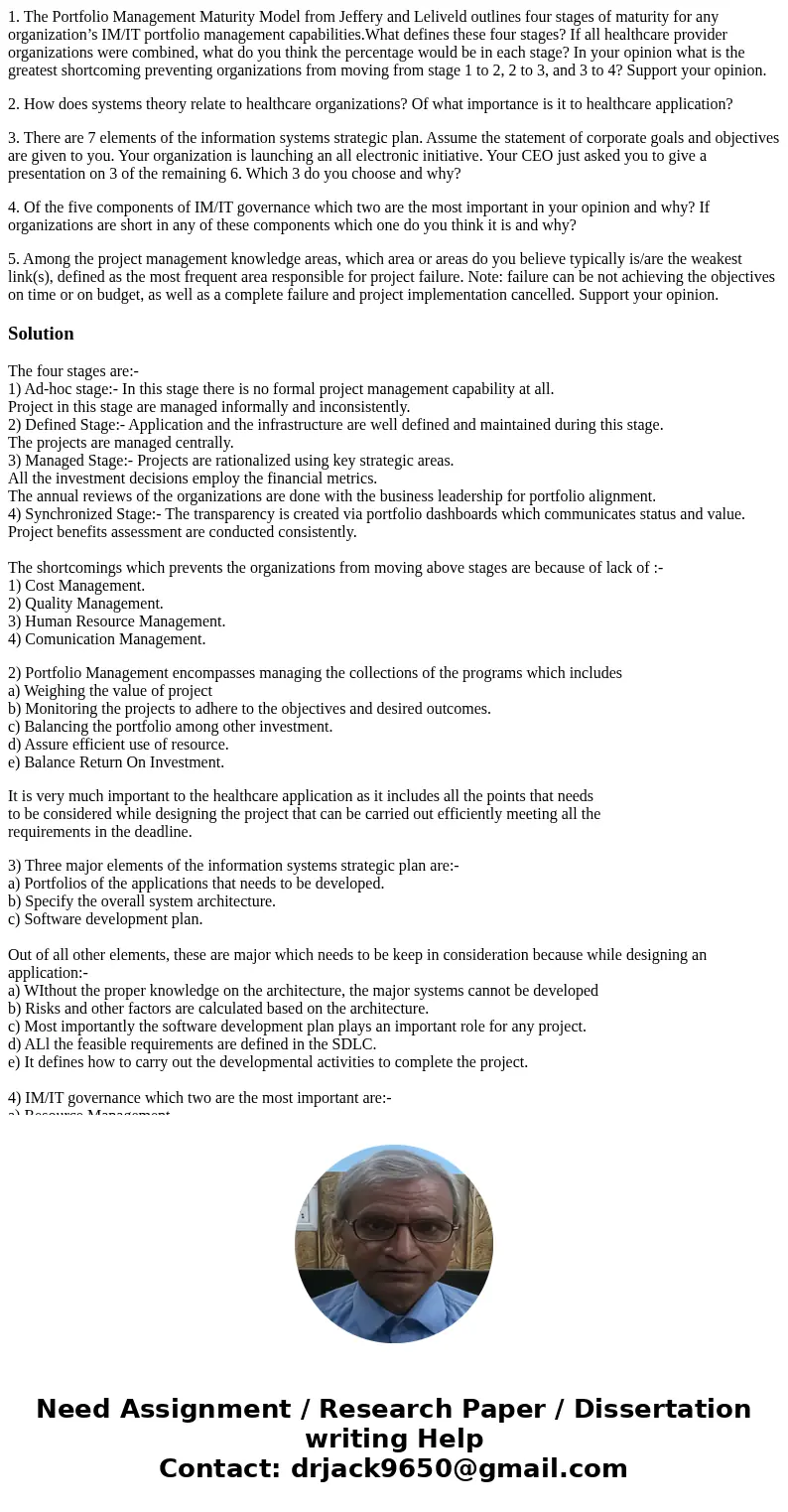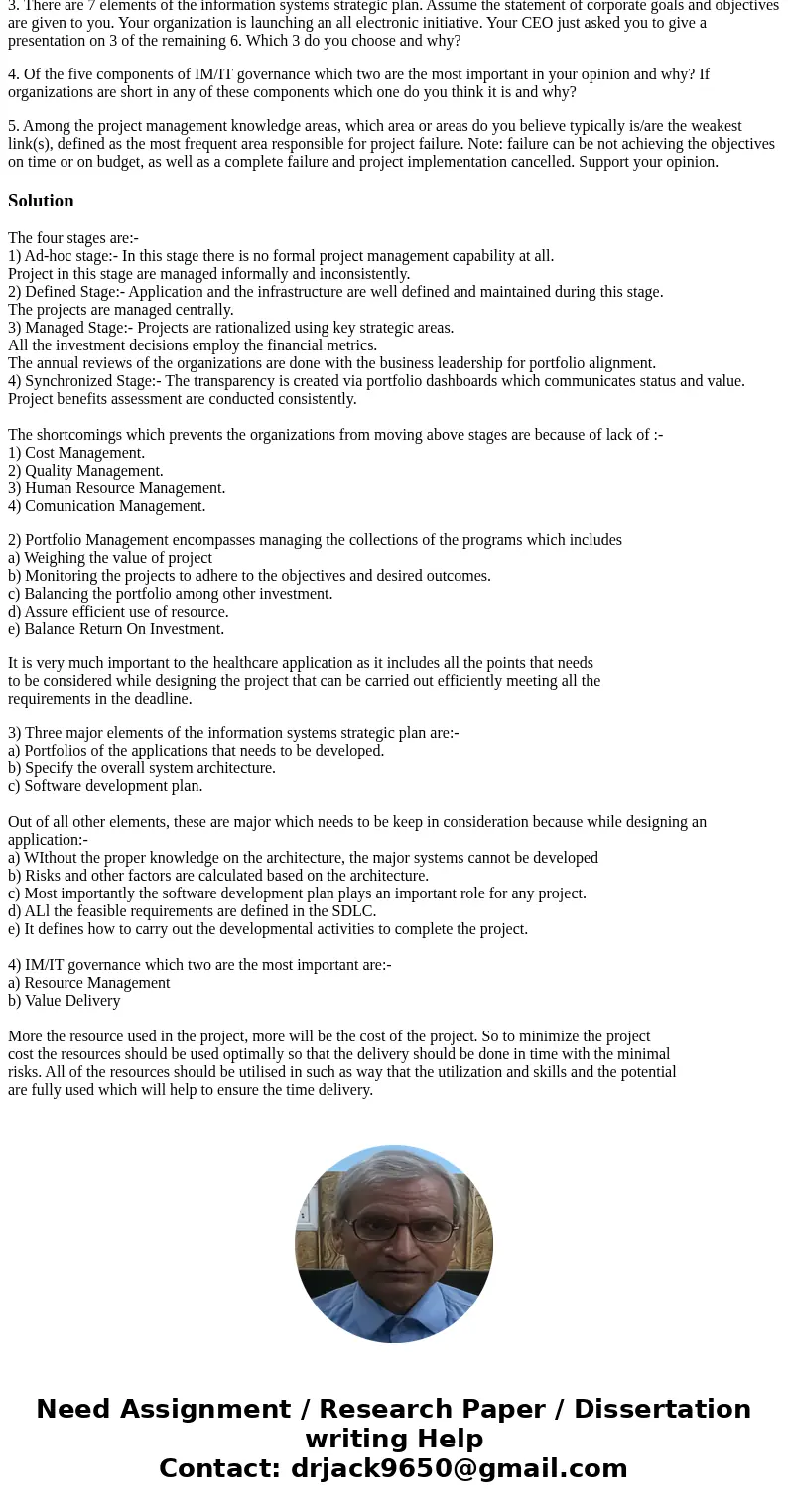1 The Portfolio Management Maturity Model from Jeffery and L
1. The Portfolio Management Maturity Model from Jeffery and Leliveld outlines four stages of maturity for any organization’s IM/IT portfolio management capabilities.What defines these four stages? If all healthcare provider organizations were combined, what do you think the percentage would be in each stage? In your opinion what is the greatest shortcoming preventing organizations from moving from stage 1 to 2, 2 to 3, and 3 to 4? Support your opinion.
2. How does systems theory relate to healthcare organizations? Of what importance is it to healthcare application?
3. There are 7 elements of the information systems strategic plan. Assume the statement of corporate goals and objectives are given to you. Your organization is launching an all electronic initiative. Your CEO just asked you to give a presentation on 3 of the remaining 6. Which 3 do you choose and why?
4. Of the five components of IM/IT governance which two are the most important in your opinion and why? If organizations are short in any of these components which one do you think it is and why?
5. Among the project management knowledge areas, which area or areas do you believe typically is/are the weakest link(s), defined as the most frequent area responsible for project failure. Note: failure can be not achieving the objectives on time or on budget, as well as a complete failure and project implementation cancelled. Support your opinion.
Solution
The four stages are:-
1) Ad-hoc stage:- In this stage there is no formal project management capability at all.
Project in this stage are managed informally and inconsistently.
2) Defined Stage:- Application and the infrastructure are well defined and maintained during this stage.
The projects are managed centrally.
3) Managed Stage:- Projects are rationalized using key strategic areas.
All the investment decisions employ the financial metrics.
The annual reviews of the organizations are done with the business leadership for portfolio alignment.
4) Synchronized Stage:- The transparency is created via portfolio dashboards which communicates status and value. Project benefits assessment are conducted consistently.
The shortcomings which prevents the organizations from moving above stages are because of lack of :-
1) Cost Management.
2) Quality Management.
3) Human Resource Management.
4) Comunication Management.
2) Portfolio Management encompasses managing the collections of the programs which includes
a) Weighing the value of project
b) Monitoring the projects to adhere to the objectives and desired outcomes.
c) Balancing the portfolio among other investment.
d) Assure efficient use of resource.
e) Balance Return On Investment.
It is very much important to the healthcare application as it includes all the points that needs
to be considered while designing the project that can be carried out efficiently meeting all the
requirements in the deadline.
3) Three major elements of the information systems strategic plan are:-
a) Portfolios of the applications that needs to be developed.
b) Specify the overall system architecture.
c) Software development plan.
Out of all other elements, these are major which needs to be keep in consideration because while designing an application:-
a) WIthout the proper knowledge on the architecture, the major systems cannot be developed
b) Risks and other factors are calculated based on the architecture.
c) Most importantly the software development plan plays an important role for any project.
d) ALl the feasible requirements are defined in the SDLC.
e) It defines how to carry out the developmental activities to complete the project.
4) IM/IT governance which two are the most important are:-
a) Resource Management
b) Value Delivery
More the resource used in the project, more will be the cost of the project. So to minimize the project
cost the resources should be used optimally so that the delivery should be done in time with the minimal
risks. All of the resources should be utilised in such as way that the utilization and skills and the potential
are fully used which will help to ensure the time delivery.


 Homework Sourse
Homework Sourse